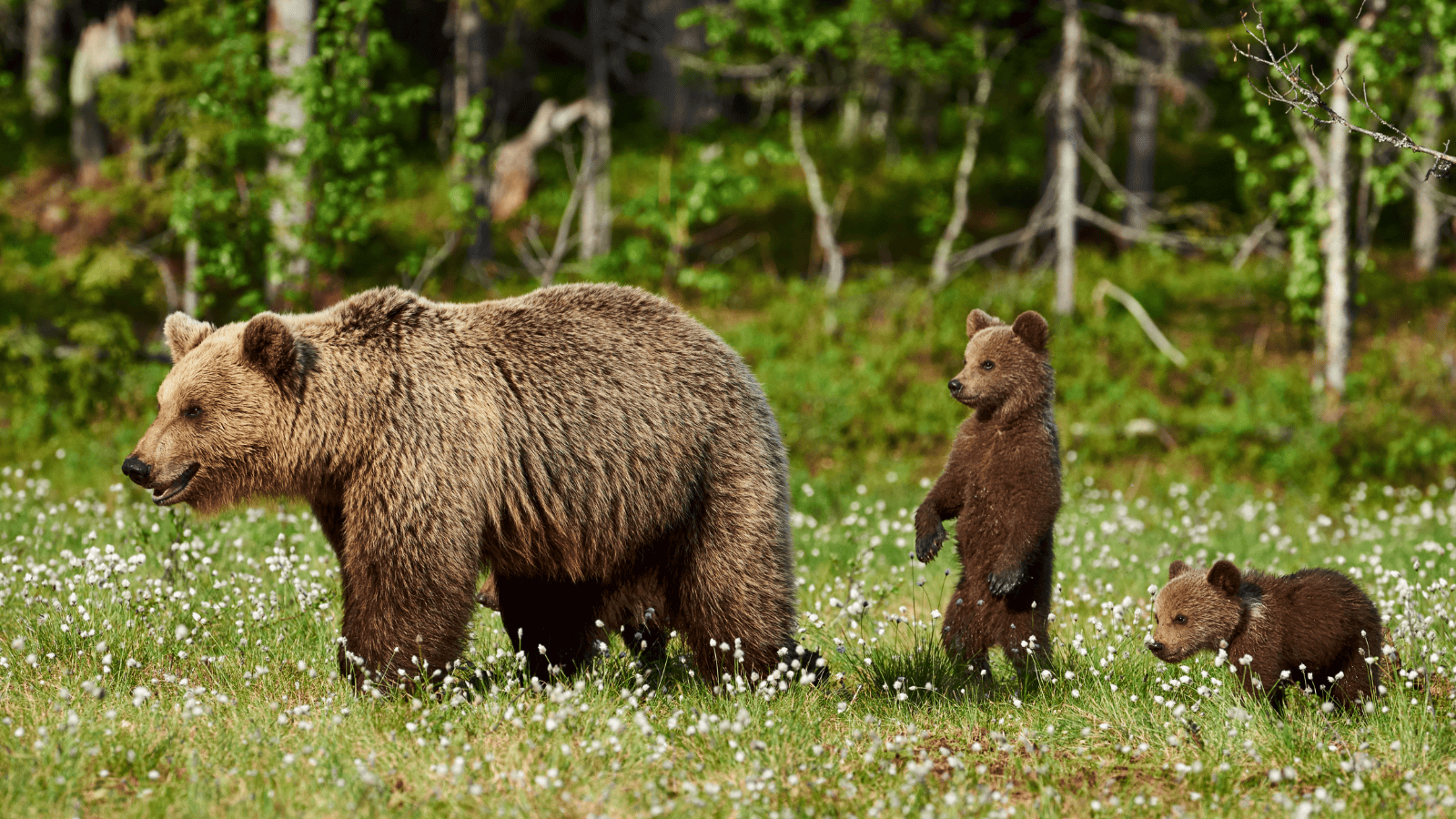Jake Cain is an entrepreneur and writer from Cincinnati, Ohio. He spends his free time driving around the country in his late 90’s conversion van, affectionately known as the “Monster Van” with his wife and 3 boys.
Viral Moment: Bear Approaches Hikers
This video garnered plenty of attention when it first circulated in 2020, and it’s easy to see why! In the video, a group of hikers is approached by a black bear in Chipinque National Park in Mexico.
The bear appears especially interested in one woman, even touching her with his paws and sniffing her hair!
All of the hikers remained calm and still during this video, moving backward only after the bear seemed to lose interest. But was this the best way to handle a bear encounter? What should you do if you come face to face with a bear on the hiking trail?
What Should You Do If You See a Bear?

According to BearWise, encountering a black bear is rare, but it’s important to know what to do if it happens. The first step is to avoid bear encounters by making noise while hiking, camping, or fishing in bear country.
If you do encounter a black bear, it’s important to stay calm and not run away. Instead, make yourself look big, make loud noises, clap your hands, and continue to back away. If a black bear becomes aggressive and charges you, stand your ground and use bear spray if you have it.
Finally, reduce the likelihood of a bear encounter by removing any potential attractants such as garbage, birdseed, or pet food from your yard.
What Not To Do When You See a Bear
According to National Park Service, there are several things that you should avoid doing if you encounter a bear.
First of all, do not run away, as bears can outrun humans, and running away may trigger the bear’s predatory instinct.
Climbing a tree is also not advised, as bears are excellent climbers and can easily follow you up.
Do not make direct eye contact with the bear, as it may perceive it as a threat. You should also avoid making any sudden movements or loud noises, as this may startle the bear and cause it to become aggressive.
Finally, do not approach the bear or attempt to feed it, as this can habituate the bear to human food and lead to dangerous conflicts in the future.
What Types of Bears Live in US National Parks?

The US national parks are home to two types of bears: the brown bear (also known as the grizzly bear) and the black bear.
Brown bears are found in Alaska, Montana, and Wyoming, while black bears are found throughout the United States, including Alaska, California, Colorado, and Michigan.
Brown bears can weigh up to 1,000 pounds and have a distinctive hump on their shoulders, while black bears are smaller and lack the hump.
Both types of bears are omnivores and can be dangerous if they feel threatened or provoked. Visitors to national parks should be aware of bear safety guidelines and take precautions to avoid bear encounters.
What If a Bear Attacks?
National Park Service explains that bear attacks are incredibly rare, but offers tips for handling a bear attack in the unlikely event that one should occur.
The first step is to determine the type of bear attacking you. If it’s a brown or grizzly bear, it’s recommended to play dead by laying flat on your stomach with your hands clasped behind your neck and spreading your legs to make it harder for the bear to turn you over.
Remain still until the bear leaves the area. If the bear continues to attack, fight back using whatever you have at hand. Aim blows at the face.
On the other hand, if you’re attacked by a black bear, it’s recommended to try to escape to a secure place such as a car or building.
If escape is not possible, try to fight back using any object available and concentrate your kicks and blows on the bear’s face and muzzle.
It’s important to note that bear attacks are rare, but being mentally prepared can help you have the most effective reaction in case of an attack.
Wildlife Viewing Etiquette
According to the National Park Service, when viewing animals in national parks, it’s important to respect their space and behavior. Visitors should use binoculars or spotting scopes to view animals from a safe distance and never approach, crowd, pursue, or displace them.
It’s recommended to stay in groups, minimize noise and movement, and stay on designated trails whenever possible.
Visitors should also avoid getting between a mother and her cub, leave sick or orphaned animals alone, and give animals room to pass.
Additionally, visitors should let animals eat their natural foods and prevent them from getting human food by learning about food storage requirements.
Ultimately, visitors are responsible for their own safety and the safety of wildlife and should move away and maintain a safe distance if an animal approaches them.
Why Was The Yellowstone Bison Calf Rejected and Euthanized?

Discover the story behind the controversial euthanization of a bison calf in Yellowstone National Park and the consequences of human intervention in wildlife conservation efforts. Learn about the incident that occurred when a Hawaii man tried to help a newborn bison calf but ended up causing its herd to reject it, resulting in the calf’s euthanization. Learn about the park’s regulations and guidelines and the importance of respecting wildlife and their natural behaviors in protected areas.
When Bison Selfies Go Wrong: Highlighting The Internet’s Funniest Reactions

Get ready for a good laugh and a friendly reminder to keep your distance from bison with this hilarious article about a viral bison selfie gone wrong. From National Park Service selfie stats to witty Twitter reactions, this article has got it all. Learn from this woman’s mistake and avoid winning a Darwin Award by keeping your distance from these majestic creatures.
How To React If You Encounter A Bear: A Safety Guide

A bear sighting while hiking can be exciting but also frightening! Discover the dos and don’ts of bear encounters, including how to make noise to avoid encounters, how to react if you see a bear, what to do if a bear attacks, and wildlife viewing etiquette. Gain valuable insights into how to stay safe in bear country and respect wildlife and their natural behaviors in protected areas.
Interacting With Wildlife In National Parks: Wildlife Safety

Wildlife sightings are one of the most exciting parts of visiting a national park! Keep yourself and the animals both safe with these dos and don’ts of wildlife encounters, including how to stay at a safe distance, never feed or touch the animals, and specific guidelines for interacting with bears, moose, bison, and elk. Gain valuable insights into how to respect wildlife and their natural behaviors in protected areas, and enjoy a safe and enjoyable wildlife viewing experience.

